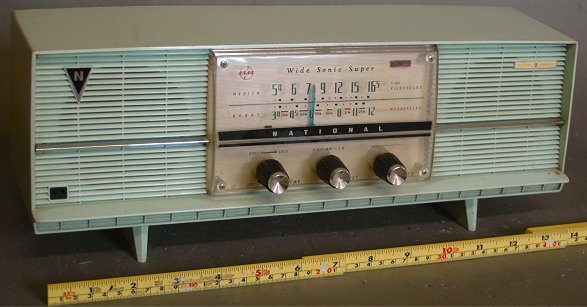
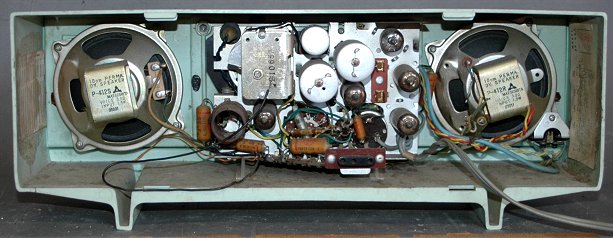
Popular Radio Sets with Plastic Cabinet
- 1960-65 -
According to the manufacturer’s catalogue in the early 1960s, the last
era of vacuum tube radios, the types of transistor radios increased, and
small plastic sets became the mainstream for stationary vacuum tube radios.
Large-scale high-fidelity radios became less common around 1963 due to
the spread of small stereo sets.
Due to the development of the chemical industry and molding technology,
the quality of plastic cabinets has improved and the cost has decreased.
Almost of sets had similar line up of The circuit is almost the same for
all manufacturers, and there is no particular individuality other than
the cabinet design. Some use transistor radio technology to use bar antennas
and printed circuit boards. Most of the sizes are small, about 30 cm wide,
with speakers of about 10 cm, and large plastic radios are no longer seen.
Initially, shortwave and medium wave 2-band model was the mainstream, but
around 1963, 3-band models with FM increased, and at the end shortwave
was dropped and. It became a model configuration of the AM-FM model that
is still often seen today and cheaper AM only model.
[Index of Prices] 1960 (Unit: JPY)
Starting salary of school teacher: 10,000, Pencil: 10.00, Electric bulb (60W): 65.00, Cigarette (Golden Bat): 30.00
Exchange rate: $1.00 = JPY 360.00
NOTICE:
Gothic is latest updates.
When not mentioned specially, all set are transformer-less super heterodyne,
all prices are original retail price.
Japanese
terms or company names that is untranslatable are shown in Italics.
"National" Products by Matsushita Electric Industrial Co., Ltd
DX-485 2 Band 5 tubes 1960 JPY 7,000
GX-230 2 Band 5 tubes 1962
RE-124 5 tubes 1964
RE-750D FM-AM 5 tubes 1964-67 JPY 9,800
"Sharp" products by Hayakawa Electric Industry Co., Ltd.
UC-102 2 Band 5 tubes 1962?
UK-70 2 Band 5 tubes 1963
"Toshiba"products by Tokyo Shibaura Electric Co., Ltd.
5YC426 "KanariyaGS" 2 Band 5 tubes 1961?
7FM-10 3Band with FM 7 tubes 1962-63 JPY 14,800
"General" prodcts by Yaou Radio MFG. Co., Ltd.
MB201L/R for Stereo 5 tubes 1962?
5MA-826 2 Band 5 tubes 1962
6MA246 2 Band 5 tubes 1963?
"Sanyo" products by Sanyo Electric Co. Ltd.
SF-41 2 Band 5 tubes 19628 JPY 7,300
"Victor" products by Victor Company of Japan
5A-2206AB 2 Band 5 tubes 1960 JPY 7,100
5A-245 SCHOOL RADIO 2 Band 5 tubes 1965
"Columbia" products by Nippon Columbia Co. Ltd.
Model unknown 2 Band 5 tubes 1962?
"Hitachi" products by Hitachi Ltd.,
S-541 2 Band 5 tubes 1965?
"Mitsubishi" products by Mitsubishi Electric Co.,Ltd.
6P-616 3Band with FM 6 tubes 1963
"Onkyo" products by Osaka Onkyo Co., Ltd.
OS-195 2 Band 5 tubes 1963?
"FUJI" products by Fuji Denki Seizo Co., Ltd.
TRV-352 3Band with FM 6 tubes 1963?
Other Manufacturer's products
ECHO 5 tubes mfr: unknpown 1961?-64?
President 5 tubes mfr: unknpown 1964?
"National" Products by Matsushita Electric Industrial Co., Ltd
DX-485 2 Band 5 tubes 1960 JPY 7,000


TUBES: 12BE6-12BA6-12AV6-30A5-35W4, BC and SW, Dual Speakers (parallel
connected)
Intermediate 2 Band 5 tubes. Such a two-speaker radio became popular in
line with the stereo trend. To simplify the structure, the chassis is a
single flat plate arranged vertically. It can be seen that the chassis
is the same as GX-230 . You can see how to make a product whose contents are standardized and
differentiated only by the difference in cabinets.
Appeard on the magazine "Musen to Jikken"(The Radio Experimenter's Magagine) 6/1960 published by Seibundo-Shinkosha
(Collection No.11251)
GX-230 2 Band 5 tubes 1962
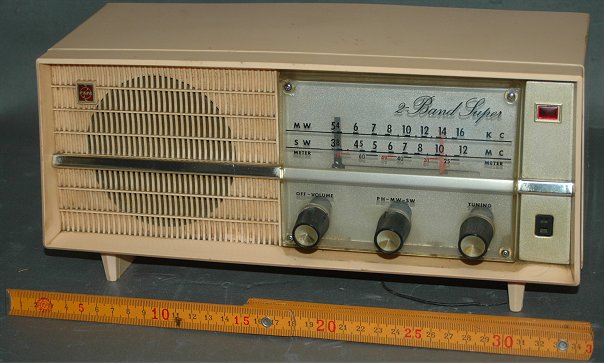
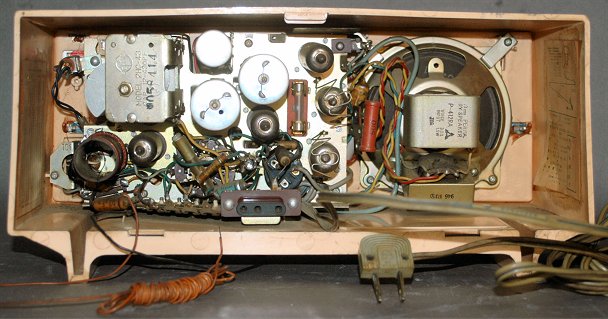
TUBES: 12BE6-12BA6-12AV6-30A5-35W4, BC and SW, 10cm Speaker
One of standard 2band radio set in Japan. Vertical chassis equipped ear
phone jack and external pick up input terminal.
(Collection No.11654)
RE-124 5 tubes 1964
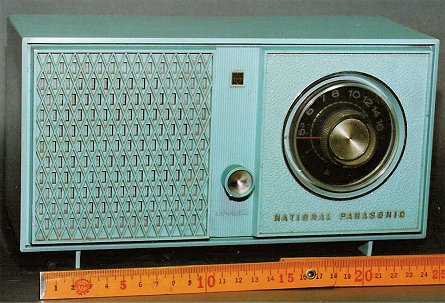
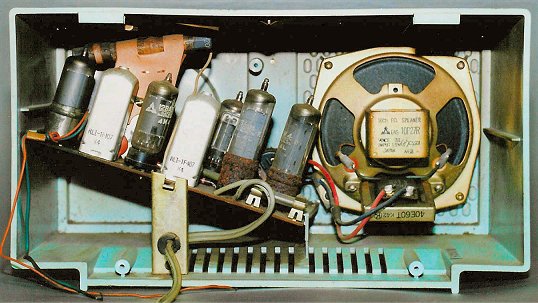
TUBES: 12BE6-12BA6-12AV6-30A5-35W4, BC only
One of the last products as a vacuum tube radio. It uses the NATIONAL PANASONIC
brand. A printed circuit board and a bar antenna are used, and the board
is placed diagonally to align the directly connected knobs. Such a layout
was common on low-priced American radios of the same period. It can be
called the cheapest version of radio.
(Collection No.11419)
RE-750D FM-AM 5 tubes 1964-67 JPY 9,800
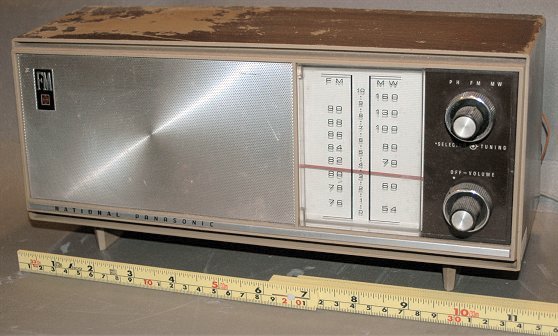
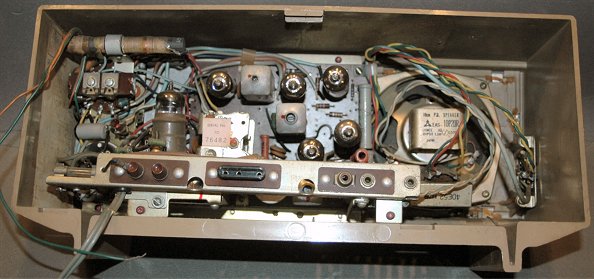
TUBES: 17EW8 - 12BE6 - 12BA6 - 12AV6 - 30A5,
SEMICONDUCTOR: Diodes used for FM detector and rectifier.
One of the last products as a vacuum tube radio. It uses the NATIONAL PANASONIC
brand. hortwave was dropped and. It became a model configuration of the
AM-FM modei. A printed circuit board and a bar antenna are used. This model
equipped the FM MPX terminal and REC-OUT terminal.
(Collection No.11086)
"Sharp" products by Hayakawa Electric Industry Co., Ltd.
UC-102 2 Band 5 tubes 1962?
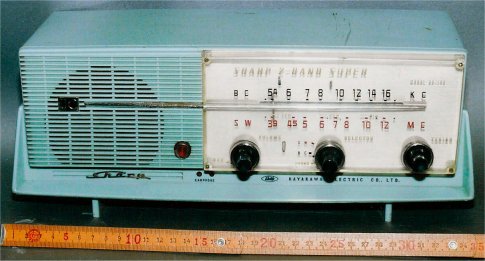
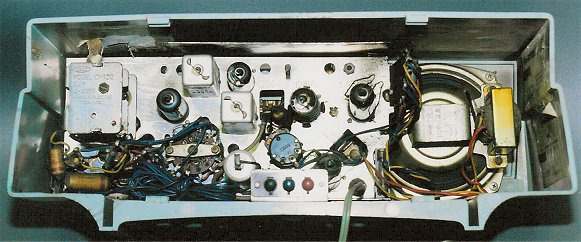
Tubes: 12BE6-12BA6-12AV6-35C5-35W4, BC and SW, 10cm Speaker
Intermediate 2 Band 5 tubes model. This model equipped the ear phone jack
and external pick up input terminal.
(Collection No.11436)
UK-70 2 Band 5 tubes 1963
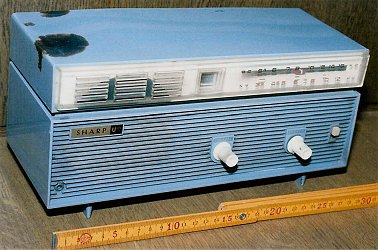
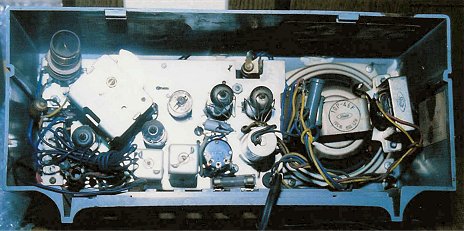
TUBES: 12BE6-12BA6-12AV6-35C5-35W4, BC and SW, 10cm speaker (Sharp Model
10P-46F)
One of the latest products as a vacuum tube radio. This model equipped
the ear phone jack and no external pick up input terminal.
(Collection No.11248)
"Toshiba"products by Tokyo Shibaura Electric Co., Ltd.
5YC426 "Kanariya GS" 2 Band 5 tubes 1961?
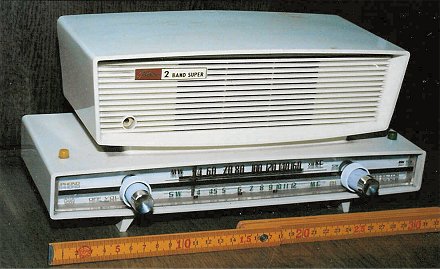
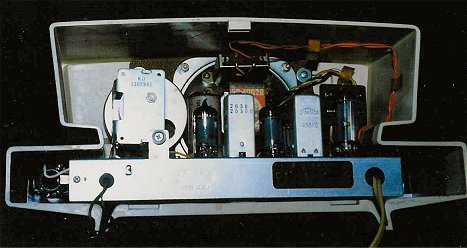
TUBES: 12BE6-12BA6-12AV6-30A5-35W4, BC and SW, 10cm Speaker
Standard circuit and size, but the cabinet is a two-band with a unique
design reminiscent of modern architecture at the time
(Collection No.11266)
7FM-10 3Band with FM 7 tubes 1962-63 JPY 14,800
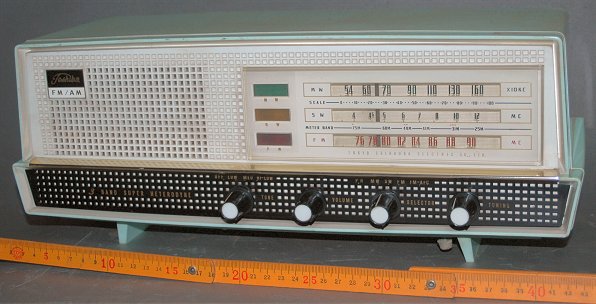
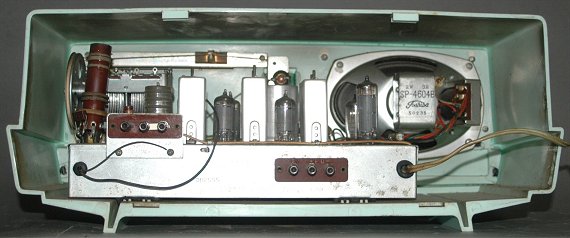
TUBES, 12DT8-12DT8-12BA6-12BE6-12BA6-12AV6-30A5, SEMICONDUCTORS: 1N60 Se-rectifier
Intermediate 3 Band with FM model.
(Collection No.11630)
"General" prodcts by Yaou Radio MFG. Co., Ltd.
MB201L/R 5 tubes for Stereo (1962? )
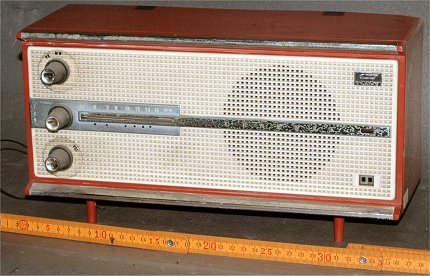
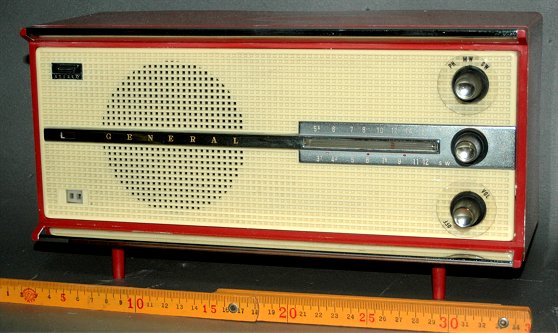
MB201L MB201R
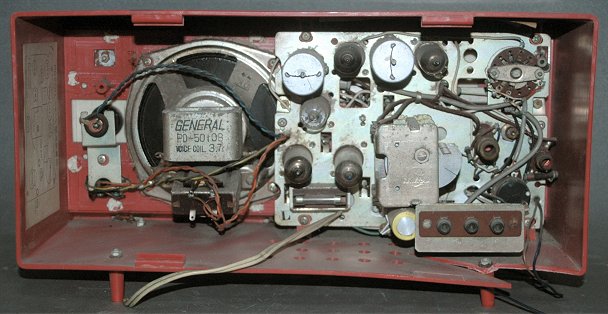
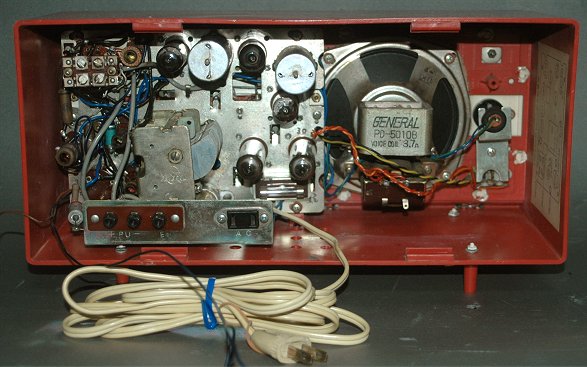
TUBES: 12BE6-12BA6-12AV6-30A5-35W4
Although it is 5 tubes with no circuit characteristics, "L" model and "R" model that are symmetrical to the left and right are prepared. This set is a stereo broadcasting radio that uses two medium waves. " L" model equipped only AM is available for L ch.
The cabinet and chassis are devised so that they can be used of common parts. Medium-wave two-wave stereo broadcasting uses two waves such as NHK 1st and 2nd at the same time to transmit L / R signals on each radio wave, and the receiving side prepares two radios for listening. is there. <BR>
In 1954, a regular program was started as "Rittai Ongakudou" means "The 3D Music Hall", and various attempts were made such as joint broadcasting by two commercial broadcasters and simultaneous stereo of TV and radio, but FM stereo broadcasting started in earnest. That is the end of that role. Stereo sets and hi-fi stereo amplifiers often have two sets of AM tuners, but small radio stereos are rare.
The cabinet of "L" model is cracked.
(Collection No.11447/11759)
5MA-826 2 Band 5 tubes 1962
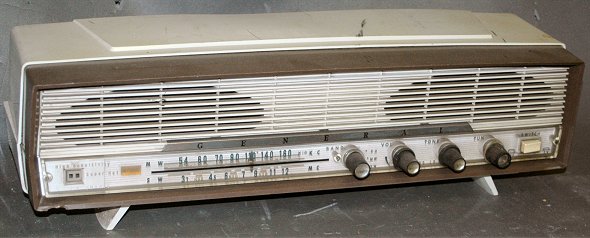

TUBES: 12BE6-12BA6-12AV6-30A5-35W4, BC and SW,
A large radio as a plastic radio. Two-speaker configuration that is conscious
of stereo. It has a complicated chassis structure to fit the wide panel.
Silver paper is pasted on the back of the top plate of the cabinet to make
it an antenna.
(Collection No.11735)
6MA246 2 Band 5 tubes 1962?
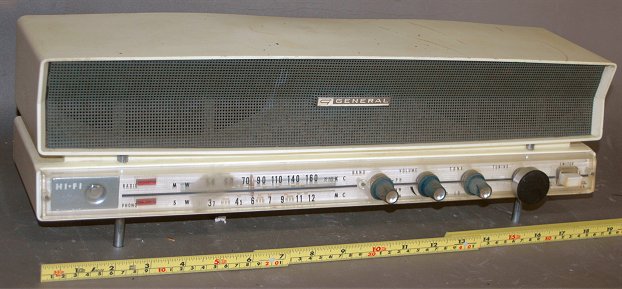
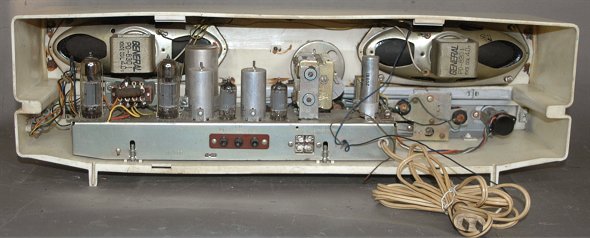
TUBES: 12BE6-12BA6-32A8-32A8-6ME10, SEMICONDUCTORS: 1N34 HR24, BC and SW,
A 50 cm wide large hi-fi radio. Two-speaker configuration that is conscious
of stereo. It has a push-pull output amplifier stage.
Large knob at right side was un-original
(Collection No.11508)
"Sanyo" products by Sanyo Electric Co. Ltd.
SF-41 2 Band 5 tubes 1962 JPY 7,300
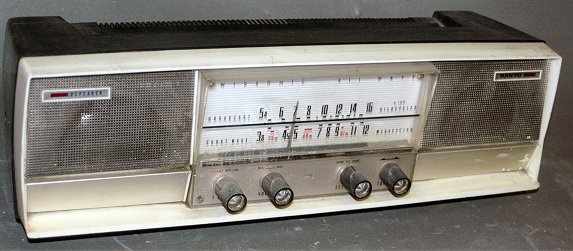
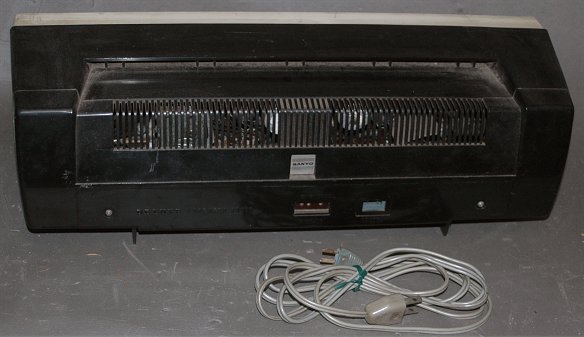
TUBES: 12BE6-12BA6-12AV6-30A5-35W4, BC and SW,
Intermediate 2 Band 5 tubes. Such a two-speaker radio became popular in
line with the stereo trend. The speaker is just parallel connected. By
this time, exports to the United States were flourishing. To certificated
to safety standard, the structure is such that the AC cord can be pulled
out when the cabinet is removed.
(Collection No.11079)
"Victor" products by Victor Company of Japan
5A-2206AB 2 Band 5 tubes 1960 JPY 7,100
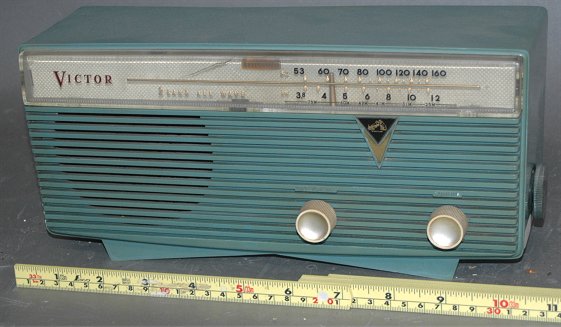
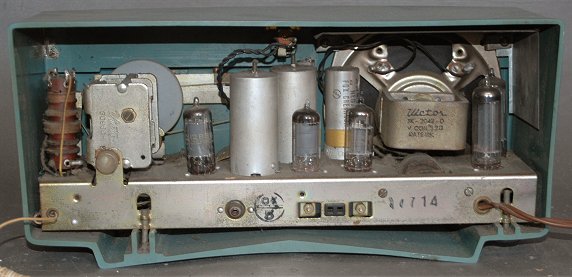
TUBES: 12BE6-12BA6-12AV6-35C5-35W4, BC and SW,
Victor's small transformerless 5 tubes. Although it is a low-priced product
for the company, it is expensive compared to other companies.
(Collection No.11141)
5A-245 SCHOOL RADIO 2 Band 5 tubes 1965
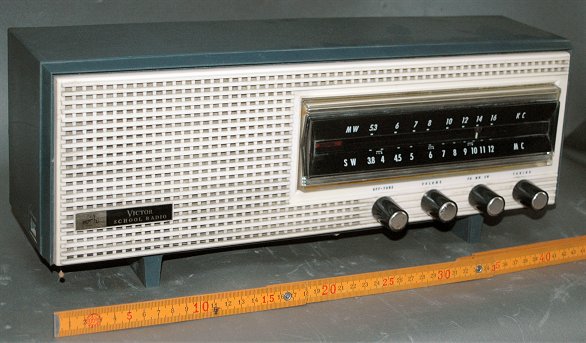
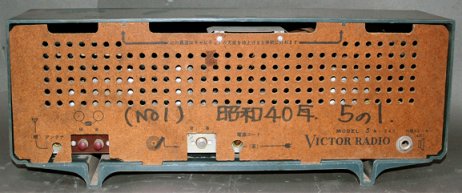
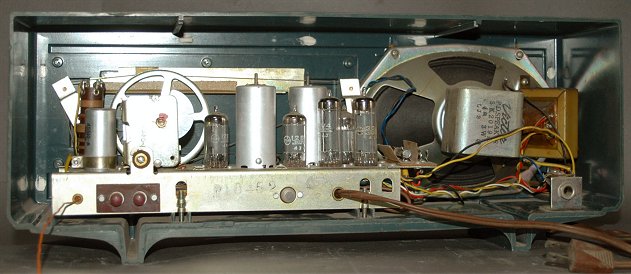

TUBES: 12BE6-12BA6-12AV6-30A5-35W4 , BC and SW,
5 tubes for school broadcasting. The circuit is quite ordinary, but it
differs from the home set in that it has a recording output and an external
speaker terminal. The speaker is larger than the home set, the cabinet
is thicker, and it is made sturdy.
It seems that this set was actually used in elementary school, and the
purchase and class name are written on the back cover. After the spread
of educational broadcasting on TV, school broadcasting on TV became mainstream,
and educational broadcasting on radio became centered on programs for individuals
such as language courses and supplementary lessons. This set is one of
the last vacuum tube radios, and one of the last days when radio was the
center of educational broadcasting.
(Collection No.11642)
"Columbia" products by Nippon Columbia Co. Ltd.
Model unknown 2 Band 5 tubes 1962?
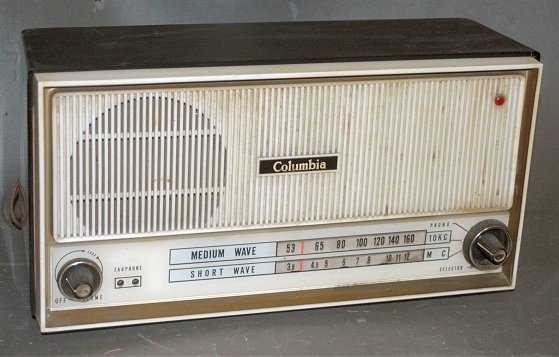
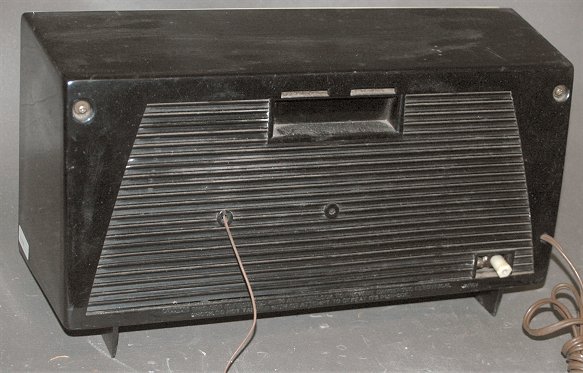
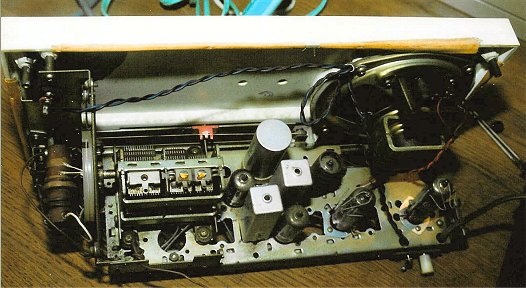
TUBES: 12BE6-12BA6-12AV6-30A5-35W4, BC and SW,
Columbia's 2 Band 5 tubes set. No remobable back cover in consideration
of safety. It's not portable, but it has a dent on the back that makes
it easy to move.
The model number of this set is unknown because the label is lost.
(Collection No.11286)
"Hitachi" products by Hitachi Ltd.,
S-541 2 Band 5 tubes 1965?
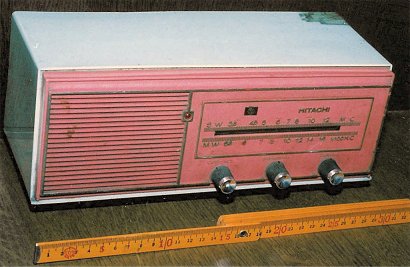
TUBES: 12BE6-12BA6-12AV6-30A5-35W4, BC and SW,
One of the latest products as a vacuum tube radio. The HITACHI logo has
been renewed. After this, the company will continue to sell slightly smaller
transistorized room radios.
"Mitsubishi" products by Mitsubishi Electric Co.,Ltd.
6P-616 3 Band with FM 6 tubes 1963?
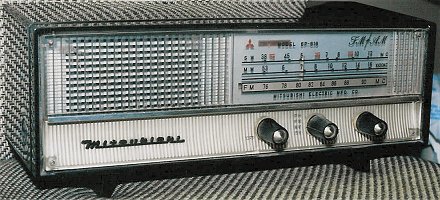
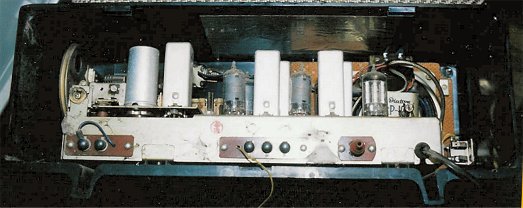
TUBES: 17EW8 - 12BA6 - 12BE6 - 12BA6 - 19T8 - 30A5
SEMICONDUCTOR: Diodes used for FM detector and rectifier.
Small 3 Band with FM model. Around this time, the number of small plastic
sets with FM is increasing.
(Collection No.11347)
"Onkyo" products by Osaka Onkyo Co., Ltd.
OS-195 2 Band 5 tubes 1963?
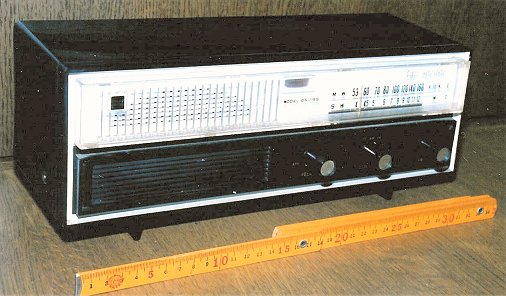
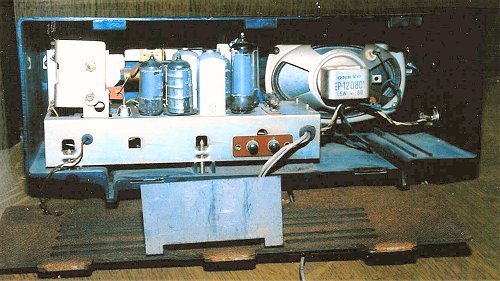
TUBES: 12BE6-12BA6-12AV6-35C5-35W4, BC and SW,
One of the last products as a vacuum tube radio. It has the same mini plug
earphone terminal and pickup terminal as the current one.
Onkyo was well known as speakers, however, there are no particular features as audio makers. Onkyo in this era seemed to dream of a home appliance maker, producing TVs and radios for the general public. In particular, the continued focus on TV production caused the subsequent business crisis.
(Collection No.11259)
"FUJI" products by Fuji Denki Seizo Co., Ltd.
TRV-352 3 Band with FM 6 tubes 1963?
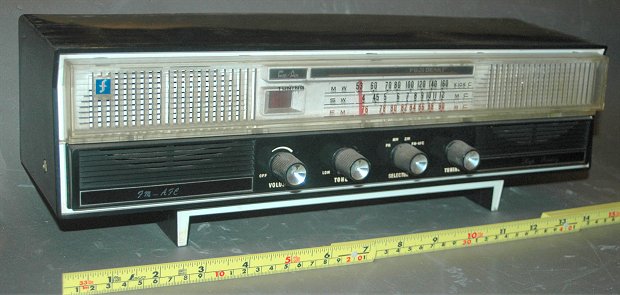
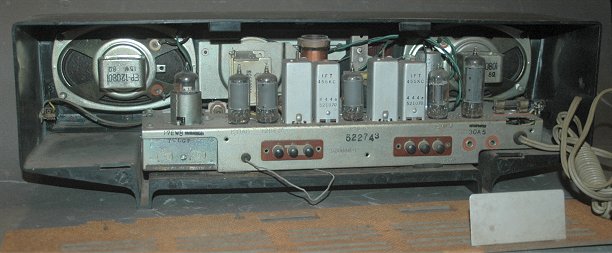
TUBES: 17EW8 - 12BE6 - 12BA6 - 12BA6 - 12AV6 - 30A5, BC:535-1605kc,SW:3.8-12Mc,FM:76-90Mc
Diodes: 2-1S446 SM-150a
FUji's tube radio set with FM. A lamp is used as tuning indicator instead of a magic eye.
Fuji Electric which entered the home appliances market in the 1960s. However, its sales force was weak and it was decided to withdraw in the 1970s.
(Collection No.11166)
Other Manufacturer's products
ECHO 5 tubes mfr: unknown 1961?-64? (Export model)
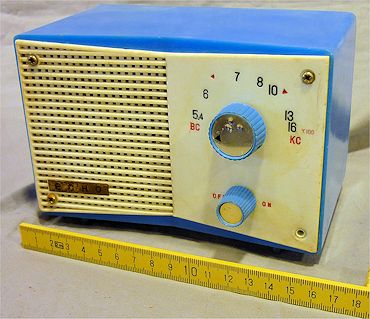
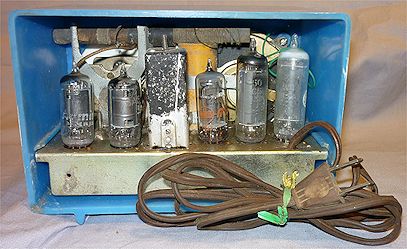
Early type ?
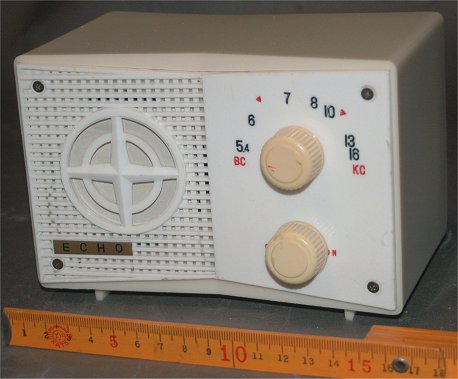
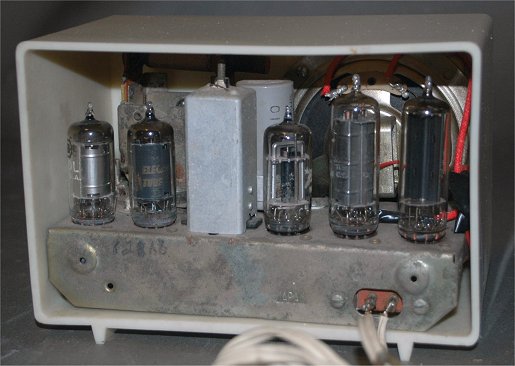
Later type ?
TUBES: 12BE6 12BA6 12AV6 50C5 35W4, BC only, AC117V
A small 5-tubes super-heterodyne set for export to the US markets. The structure of the vacuum tube is general, but the frequency conversion and intermediate frequency stages are untuned. For this reason, the variable condenser is a single unit, and the IFT is only one. This set is made in Japan, but the vacuum tubes are made in U.S.A.
Many such small 5-tubes super-heterodyne set were made for export, but some were also sold to the domestic market through advertisements in radio magazines. Two types of this model with different designs and chassis structures have been confirmed.
(Collection No.11990 / 11940)
President 5 tubes mfr: unknown 1964?
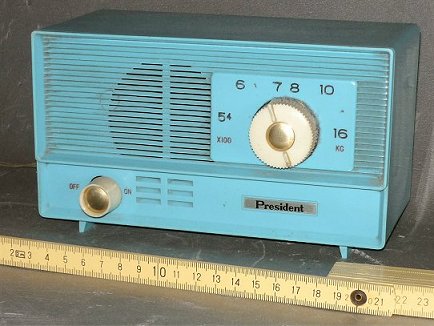
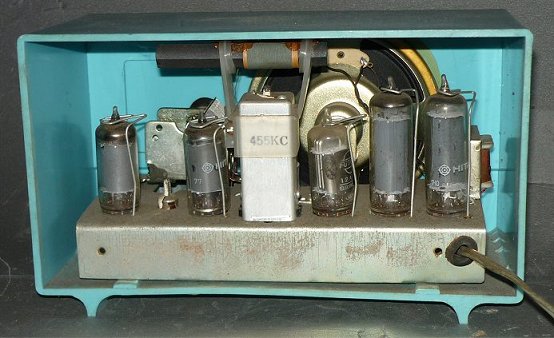
TUBES: 12BE6 12BA6 12AV6 35C5 35W4
A small 5-tubes super-heterodyne set The structure of the vacuum tube is
general, but the frequency conversion and intermediate frequency stages
are untuned. For this reason, the variable condenser is a single unit,
and the IFT is only one. And this set bae antenna to increase a gain of
RF circuit.
Many such small 5-tubes super-heterodyne set were made for export, but some were also sold to the domestic market through advertisements in radio magazines. Two types of this model with different designs and chassis structures have been confirmed.
(Collection No.11940)